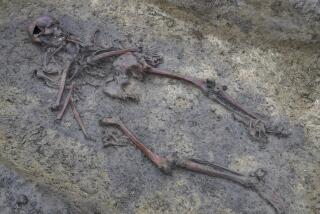Vikings Flashed More Than Pearly Whites
- Share via
STOCKHOLM — Viking raids gave Norsemen a reputation in medieval Europe as bloodthirsty marauders. Recent archeological finds show they also may have been vain -- caring as much for the brilliance of their teeth as the bite of their swords.
A study of skeletal remains from 1,000-year-old burial sites in southern Sweden suggests some Norsemen used iron files to carve grooves into their teeth, probably to insert colorful decorations, anthropologist Caroline Arcini said.
She believes the grooves, which she found in the teeth of 10% of male skeletons but none of the women, were either pure decoration or meant to show affiliation to a social class or trade group.
Tooth-filing was widespread among Native Americans at the time, but Arcini’s discovery is the first indication that it also was practiced by medieval Europeans.
Although researchers have evidence the Vikings were the first Europeans to reach America, Arcini said her discoveries didn’t necessarily mean the two cultures exchanged ideas on dentistry in the 11th century.
“It is probably just a coincidence,” she said. “Things pop up in different places in the world without there necessarily having been any contact.”
The Vikings set out in their long ships in the late 8th century to raid the coasts of northern Europe. What began as minor expeditions by adventurous chieftains later escalated into full-scale invasions of Britain and northern France led by Norwegian and Danish kings and earls.
Swedish Vikings headed east. They crossed the Baltic Sea and sailed up the rivers of Russia, reaching as far as Constantinople.
Arcini’s study, first published in the American Journal of Physical Anthropology, found horizontal grooves across the upper front teeth of 24 men among 557 skeletal remains of men and women at four grave sites.
The grooves, often in pairs or triplets, were too carefully made to be the result of chance, she said.
Arcini, who works for the Swedish National Heritage Board, said it was unclear what colors were used to fill the grooves, but it was probably black or red.
“I think it was rather pretty,” she said. “What they had in common was that they had to laugh pretty hard” for the teeth to be visible because the grooves were quite high up.
Arcini hopes further studies will reveal where the practice arose and how it spread.
More to Read
Sign up for Essential California
The most important California stories and recommendations in your inbox every morning.
You may occasionally receive promotional content from the Los Angeles Times.













